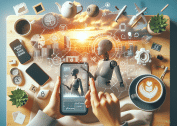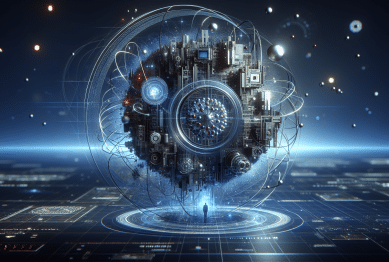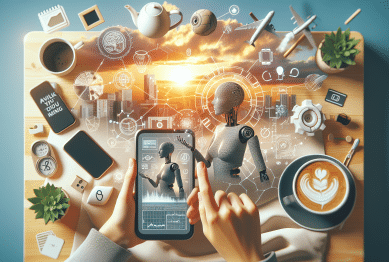Artificial intelligence is no longer just science fiction—it’s woven into everyday routines. This in-depth guide explores how smart technologies adapt to habits, personalize experiences, and contribute to decisions, revealing just how much AI shapes what’s around us.
What Artificial Intelligence Really Means for Everyday Technology
Artificial intelligence has become an invisible force powering technology in subtle but meaningful ways. Machines now regularly interpret speech, recommend music, automate navigation, and even help detect fraud. Each time a smartphone unlocks with facial recognition or a digital assistant responds to a spoken request, extensive AI models work in the background. Far from being reserved for large research labs, these systems use hardware and cloud-based AI to interpret data, adjust to user behavior, and deliver convenient, seamless experiences. Many daily apps and functions use natural language processing, predictive models, or deep learning to optimize outcomes without fanfare.
This transformation is possible thanks to enormous data sets and sophisticated algorithms that adapt over time. AI-driven personalization allows for tailored suggestions on streaming platforms, dynamic road navigation, targeted advertisements, and even predictive text suggestions in messages. The adaptability of AI means these platforms can become better with every interaction, making technology feel more intuitive. For example, the more a smart home device hears commands, the more accurately it responds, learning accents and phrases unique to its environment. Shoppers receive curated product lists, while online platforms present news tailored to reading habits—all rooted in real-time machine learning feedback loops.
Increasingly, even mundane choices—such as setting a thermostat or adjusting light levels—are influenced by AI-driven automation. Smart systems can sense occupancy patterns, track weather reports, and gradually adjust to optimal comfort levels. Decision-making becomes effortless, and machine learning helps forecast needs ahead of time. Artificial intelligence is thus not something limited to dramatic robots or science fiction; it’s the quiet evolutionary upgrade that makes everyday tech more efficient, more responsive, and often more enjoyable for individuals everywhere.
Invisible Assistants: AI’s Role in the Home and Workplace
While voice-activated devices are a familiar symbol of home AI, the reach of artificial intelligence quietly extends through almost every corner. Algorithms filter spam from inboxes, organize digital photos using face and object detection, and automate calendar reminders. Smart fridges manage shopping lists; robotic vacuums map floor plans and adjust routes based on clutter or time of day. In offices, AI tools help schedule meetings by analyzing crowded calendars or summarize lengthy emails into actionable highlights. These digital assistants continuously learn from user patterns, aiming to save time and anticipate needs.
In professional environments, artificial intelligence improves productivity in unexpected ways. Workflow automation uses machine learning to flag relevant documents, categorize files, or prioritize support tickets. These efficiencies grow as the system analyzes historic data and adjusts to preferences. For creatives, design software can apply filters, adjust layouts, or even generate written content drafts—all using trained AI models. Security monitoring platforms leverage AI to quickly spot unusual access patterns or suspicious behaviors, alerting teams before a threat escalates. These integrations may be invisible to many workers, but they underpin an ecosystem designed for increased effectiveness.
Home AI is growing more sophisticated, facilitating smarter energy management and security. Thermostats use historical usage patterns and weather data to optimize heating and cooling schedules, while AI-driven cameras distinguish between familiar faces and potential intruders (Source: https://www.energy.gov/eere/buildings/articles/april-2021-building-technologies-office-funding-announcement-0). As these systems evolve, they learn individual routines, adapt predictively, and free up time for more important activities. Automation once reserved for industry is now a household convenience—changing how homes and workplaces feel, function, and evolve with daily life.
Transportation and Navigation: AI at Work on the Move
Transportation is being transformed by AI, with navigation apps and smart vehicles leading the charge. Algorithms crunch billions of data points from traffic sensors, rider feedback, and weather feeds, offering real-time detours or arrival estimates. This helps drivers avoid congestion, reduces commuting time, and improves safety. Autonomous vehicle research, another headline-grabber, is built upon layers of machine vision and predictive modeling; vehicles gather input from cameras, lidar, radar, and GPS, then use that data to make split-second decisions (Source: https://www.transportation.gov/research-technology/data).
Public transportation also leverages AI to optimize scheduling, fleet management, and route planning. Trains and buses collect data on ridership and travel times, then adapt resources dynamically to meet demand and cut delays. This same approach is used in logistics, where predictive analytics help companies chart more efficient delivery routes, streamline supply chains, and even forecast weather-related disruptions. For many people, ride-sharing apps have become the default way to book a trip—these too rely on AI to match drivers and riders, balance fare pricing, and ensure quick arrivals.
AI is also being applied to safety monitoring and accident prevention in road, rail, and air travel. Machine learning analyzes incident patterns to suggest improvements—sometimes long before problems are visible to humans. As more transportation systems become connected, artificial intelligence will enable further automation, reducing manual intervention and promoting smoother, safer, and more resource-efficient journeys for everyone.
Health and Wellness: The Subtle Power of AI Guidance
Artificial intelligence now plays a discreet yet significant part in many aspects of health and wellness. In medical research, AI scans clinical data for hidden patterns and accelerates drug discovery. Hospitals use predictive analytics for inventory management, patient admissions forecasting, and planning optimal staff schedules. Fitness trackers and wearable health devices rely on machine learning to offer insights into sleep quality, heart rates, and activity patterns, encouraging healthier habits by translating raw data into personalized coaching (Source: https://www.nih.gov/news-events/nih-research-matters/artificial-intelligence-improves-health-outcomes).
AI tools are used in diagnostic imaging, identifying subtle anomalies in x-rays or MRI scans that could elude even seasoned experts. This boosts early detection and supports doctors in making complex decisions. Mental health care is another frontier: apps use natural language processing to screen for mood disorders or monitor wellbeing by analyzing written responses. Some hospitals experiment with chatbots for routine symptom checks, alerting health professionals only when signs indicate a higher risk. Such digital triage helps keep healthcare accessible and timely, while safeguarding privacy and confidentiality.
Even outside of clinical settings, AI powers everyday wellness apps that recommend healthy recipes, tailor workout routines, and remind users to move or hydrate. Nutrition tracking relies on image recognition; telemedicine platforms route patients efficiently based on symptoms or history (Source: https://www.cdc.gov/digital-health-strategy/index.html). These technologies work best as guidance, not a replacement for professional advice, but their influence in helping millions adopt healthier lifestyles is growing—and happening largely behind the scenes.
Shopping and Entertainment: AI Personalizes Discovery
Retailers and entertainment providers harness AI to help people discover what they love. Recommendation systems suggest products based on browsing history, preferences, and global trends, creating a more engaging shopping experience. Streaming platforms, for example, examine past viewing habits to recommend movies or shows likely to appeal to each individual. This level of personalization is only possible with smart algorithms that analyze big data in near real time, constantly evolving as new information emerges.
In e-commerce, AI not only organizes sprawling digital catalogs but also predicts purchasing behavior and manages inventory. Automated chat support answers questions instantly, helps resolve issues, and provides tailored product suggestions at any time of the day. For musicians, filmmakers, and designers, AI engines offer creative collaboration, generating music or visual content that adapts to user moods or choices. The results are experiences that feel handpicked, improving satisfaction and keeping people engaged longer on apps and platforms.
Artificial intelligence is also enhancing security for shoppers and businesses alike. Fraud detection systems scan for irregular patterns in payment data, recognize suspicious logins, and alert teams to prevent losses (Source: https://www.fraud.org/artificial-intelligence-fraud-prevention). These invisible layers of AI keep online environments safer, more interactive, and better attuned to personal tastes—allowing discovery and entertainment to feel almost effortless.
The Evolving Landscape of Ethics and Privacy
With growing AI adoption comes new questions about privacy, bias, and the impact of automation on society. These systems learn from massive datasets—which are sometimes incomplete or skewed—leading to potential bias in decisions. Organizations and governments are working to establish guidelines and regulations for responsible use of AI, encouraging transparency and fairness while minimizing risks (Source: https://www.nist.gov/artificial-intelligence).
Privacy concerns are particularly relevant as AI tools process biometrics, conversations, and personal data. Some countries and advocacy groups promote strict data handling practices and ‘explainable AI,’ ensuring decisions can be understood, challenged, and corrected. This focus on transparency helps build trust in AI-powered services, making it easier for people to accept new technologies into their lives. The pace of innovation also calls for regular review of ethical policies, especially as algorithms become more integral to sensitive fields like hiring or healthcare.
Public awareness is growing, too. Users are learning about the trade-offs between convenience and data security, adjusting device settings, and selecting services based on privacy credentials. As artificial intelligence continues to advance, ethical considerations will remain essential—helping society balance benefits with responsible innovation for safer, smarter everyday experiences.
References
1. National Institute of Standards and Technology. (n.d.). Artificial Intelligence. Retrieved from https://www.nist.gov/artificial-intelligence
2. U.S. Department of Transportation. (n.d.). Data and Research. Retrieved from https://www.transportation.gov/research-technology/data
3. U.S. Department of Energy. (2021). Building Technologies Office Funding Announcement. Retrieved from https://www.energy.gov/eere/buildings/articles/april-2021-building-technologies-office-funding-announcement-0
4. National Institutes of Health. (n.d.). Artificial Intelligence Improves Health Outcomes. Retrieved from https://www.nih.gov/news-events/nih-research-matters/artificial-intelligence-improves-health-outcomes
5. Centers for Disease Control and Prevention. (n.d.). Digital Health Strategy. Retrieved from https://www.cdc.gov/digital-health-strategy/index.html
6. National Consumers League. (n.d.). Artificial Intelligence in Fraud Prevention. Retrieved from https://www.fraud.org/artificial-intelligence-fraud-prevention









